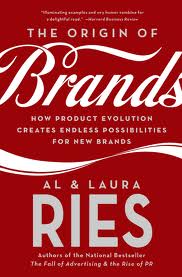The Origin of Brands

– By Al & Laura Ries
Read most books on management and they will all talk about the one key objective of companies – to maximise shareholders’ value. That objective is taken as gospel. However, there are now a growing group of companies that don’t follow the traditional stockholder-biased business model but a stakeholder relationship management business model, a model that takes into account all primary stakeholders – consumers, employees, suppliers, partners in the supply chain and the communities in which they operate. These are the companies that Sisodia, Wolfe and Sheth examine in their book – Firms of Endearment.
Based on an exhaustive survey, the authors identified an illustrative list of companies that qualify to be called Firms of Endearment: Amazon, BMW, CarMax, Caterpillar, Commerce Bank, Container Store, Costco, eBay, Google, Harley-Davidson, Honda, IDEO, IKEA, JetBlue, Johnson & Johnson, Jordan’s Furniture, LL Bean, New Balance, Patagonia, REI, Southwest, Starbucks, Timberland, Toyota, Trader Joe’s, UPS, Wegmans and Whole Foods.
These companies were loved because they went beyond the magic mantra of maximising shareholders’ value; they were obsessed with doing a greater good by involving all stakeholders in their business. Interestingly, what the writers found was that ‘the public FoEs returned 1,026% for investors over the 10 years ending June 30, 2006, compared to 122 percent for the S&P 500; that’s more than a 8-to-1 ratio.’ When they compared the FoEs with the eleven companies that Jim Collins’ had identified as Good to Great in his bestselling book, they found that ‘over a 10-year horizon, FoEs outperformed the Good to Great companies by 1,026 percent to 331 percent (a 3.1-to-1 ratio). Amazingly, none of the Good to Great companies made the cut in the list of FoEs!
So what are the set of core values, policies and operating attributes that many of the Firms of Endearment follow?
- Alignment of interests of all stakeholders. For example, Whole Foods has a formal ‘Declaration of Interdependence’ that argues that all stakeholders constitute a family.
- Modest executive salaries. Unlike many companies that give exorbitant salaries, bonuses and stock options to their CEOs and senior executives, Firms of Endearment have a much more modest compensation policy.
- Open-door policy at even the most senior levels. For example, Honda follows the waigawa principle that temporarily suspends social protocols based on rank whenever it has a big problem. This makes it possible for the juniors to present solutions to the highest level.
- Employee compensation and benefits are SIGNIFICANTLY higher than those of competition.
- More time and effort spent in employee training.
- Employee turnover is far lower than that of competitors.
- Empowerment of employees to ensure that customers have a highly satisfactory experience.
- Hiring geared towards taking in people who are passionate about the company and its products.
- Humanisation of the company experience for customers and employees.
- Genuine liking and regard for customers.
- Marketing costs lower than that of competitors; yet, customer satisfaction and retention much better.
- Treatment of suppliers as true partners; active help to suppliers to improve their productivity and profitability.
- Extremely law abiding.
- Passionate about their corporate culture and use it as a competitive advantage.
- Quick to adapt; hence are often the innovators in their industry.
The authors argue that we are now entering the Age of Transcendence as people search for higher meaning in their lives. This is transforming the very soul of capitalism and the way companies do business. Companies that are moving away from the share of wallet to share of heart are the companies that are likely to be successful in the future. Firms of Endearment have already started showing the way.
Sisodia, Wolfe and Sheth have built a set of guidelines – with lots of examples – from their illustrative set of companies that other companies would do well to emulate. If there is a problem, it is that the companies chosen in the book are after the fact; like Good to Great, Firms of Endearment identifies companies and then fits them into the framework built by the authors.
However, Raj Sisodia and others have started a movement – the Conscious Capitalism movement – with the aim of getting companies to build their businesses based on the interests of all the stakeholders. Firms of Endearment was written in 2007; since then, John Mackay (the co-CEO of Whole Foods) and Raj Sisodia have written Conscious Capitalism which, in many ways, is a follow-up and a more updated look at ‘Firms of Endearment’. Hopefully, this new capitalism will be embraced by an increasing number of companies.
Rating: A
